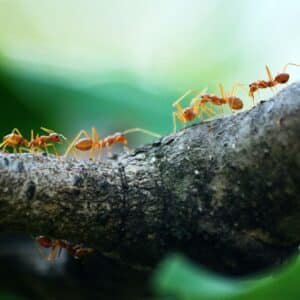
ANTS
FUN FACT
The Argentine ant, commonly found in Texas, can form "supercolonies" with millions of workers and multiple queens, making them particularly difficult to eradicate without professional help.
Schedule Your Ant RemovalCall (512) 764-5804Identification
Ants are among the most common pests found in Texas, with species such as the fire ant, carpenter ant, and Argentine ant being particularly prevalent. These social insects live in large colonies and can be found in various environments, from urban areas to rural settings. Ants are known for their organized colony structure and cooperative behavior, which makes them resilient and challenging to control.
Signs of Infestation
- Visible Trails: Ants often travel in visible trails between their nest and food sources.
- Mounds: Fire ants build distinctive mounds in open areas like lawns, gardens, and sidewalks.
- Wood Damage: Carpenter ants can cause structural damage by hollowing out wood for nesting.
- Indoor Activity: Finding ants in your kitchen, bathroom, or other areas of your home is a clear sign of an infestation.
Breeding Season
Ants can breed year-round in Texas due to the warm climate. During mating season, winged reproductive ants, known as swarmers, leave the nest to establish new colonies. This usually occurs in the spring and summer months.
Ecosystem Role
While ants can be pests, they also play essential roles in the ecosystem, including:
- Soil Aeration: Ants tunnel through the soil, which helps with aeration and nutrient cycling.
- Decomposition: They help break down organic matter, recycling nutrients back into the environment.
- Predation: Ants prey on other insects, helping to control pest populations.
Prevention Strategies
- Cleanliness: Keep your home clean, especially in kitchens and food storage areas. Regularly dispose of garbage and clean up spills.
- Seal Entry Points: Inspect and seal cracks, gaps, and holes in walls, doors, windows, and foundations to prevent ant entry.
- Proper Food Storage: Store food in airtight containers and avoid leaving pet food out overnight.
- Outdoor Maintenance: Keep trees and shrubs trimmed away from your home and remove any decaying wood or debris from your yard.
- Baiting and Traps: Use ant baits and traps to target and eliminate colonies.
Prickly Pear’s Approach
- Inspection: Conduct a thorough inspection to identify ant species and infestation levels.
- Exclusion: Seal entry points and implement barriers to prevent ants from entering your home.
- Sanitation: Provide guidance on maintaining cleanliness and reducing food and water sources.
- Targeted Treatments: Use baits, traps, and insecticides to eliminate ant colonies effectively.
- Ongoing Monitoring: Regularly monitor and adjust strategies to ensure long-term control.
Conclusion
Ants are resilient and can quickly become a significant problem if not addressed promptly. Prickly Pear offers professional services to manage ant infestations and protect your home. If you suspect an ant problem, contact us for expert assistance in maintaining a clean and pest-free environment.
